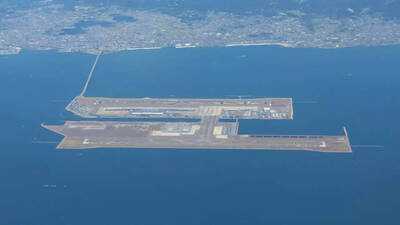Japan's Kansai International Airport is sinking into the ocean; know what went wrong

Kansai International Airport (KIX) in Japan has long been considered an engineering marvel. Built entirely on an artificial island in Osaka Bay, it serves as a major aviation hub connecting over 30 million passengers each year to 91 cities across 25 countries. Since opening in 1994, KIX has grown into one of Asia’s busiest and most critical international airports. But behind this success story lies a persistent and worsening issue: the entire airport is sinking into its soft clay foundation.
According to a report by The South China Morning Post, the original island has sunk about 12.5 feet since its opening. The second island added later during expansion, has already descended 57 feet since landfill work began. In just the last year alone, officials recorded 21 centimetres of sinking at 54 separate monitoring points on the newer island. These figures highlight a growing concern—not just about the engineering design, but also the future of this key transport hub as sea levels rise and extreme weather events become more frequent.
Despite these challenges, the airport remains fully operational, and engineers are working constantly to manage and slow down the rate of subsidence. This article explores why Kansai is sinking, how engineers are responding, and what lessons Japan has learned from this ambitious project.
Why Kansai Airport was built on water
KIX was constructed on a man-made island 5 kilometres offshore to address land shortages in the Osaka region and reduce noise complaints from densely populated areas. The engineering plan involved creating a foundation on about 20 meters of soft alluvial clay, known for its compressibility and instability.
To tackle this, engineers installed 2.2 million vertical pipe drains to speed up the soil consolidation process and used over 200 million cubic meters of landfill and 48,000 tetrapods to stabilize the site. Despite this effort, the clay base continues to compress under the airport’s weight.
As explained by Hiroo Ichikawa, professor emeritus of urban planning and policy at Meiji University, “It is sinking by less than 10 centimetres a year now, but that is slowing and manageable.” (South China Morning Post, 2024)
Why Typhoon Jebi was a wake-up call for Japan’s sinking airport
The airport’s vulnerability was fully exposed in 2018 when Typhoon Jebi, the strongest storm to hit Japan in 25 years, brought massive flooding. As reported by The Guardian, a storm surge flooded the airport’s basement-level disaster response centre and electric substation, leaving 5,000 travellers stranded without power or transport for more than 24 hours. A fuel tanker even collided with the bridge connecting the airport to the mainland, cutting off the only road access.
This event not only disrupted operations but also led engineers to reevaluate key design elements—particularly the placement of critical systems underground in a facility prone to flooding and subsidence.
Ongoing sinking of Kansai International Airport: Latest measurements and response
According to data published in The Straits Times and The Nation Thailand (June 2024), the second island experienced 21 centimetres of sinking in a single year, while the original island continues to settle at about 4 inches (10 cm) per year. Though slower than before, the subsidence has not stopped.
In response, over $150 million has been invested in upgrading the airport’s seawalls and reinforcing infrastructure. Engineers have elevated key equipment, such as power systems and disaster response centres, above potential flood levels. The goal is not to stop the sinking—because that’s impossible—but to manage it within safe limits, as emphasized by Professor Ichikawa.
“The effect of sinking was taken into consideration in the design,” he said. “Engineers are constantly monitoring conditions at KIX and are working to limit the subsidence, but nothing is impossible and it really is just a question of cost.” (South China Morning Post, 2024)
Lessons learned: A smarter airport in Nagoya
Kansai’s experience has helped shape future airport construction in Japan. When Chubu Centrair International Airport opened in 2005 near Nagoya, engineers applied key lessons from KIX—especially in choosing more stable ground and keeping essential systems above sea level.
This has paid off. According to Skytrax, Chubu Centrair has been named the world’s best regional airport for 11 consecutive years through 2025. The facility has experienced minimal subsidence and has proven far more resilient to climate risks and natural disasters.
Also read |
What is ‘Naked Flying’: The minimalist travel trend taking off around the world
 Kansai International Airport (KIX) in Japan has long been considered an engineering marvel. Built entirely on an artificial island in Osaka Bay, it serves as a major aviation hub connecting over 30 million passengers each year to 91 cities across 25 countries. Since opening in 1994, KIX has grown into one of Asia’s busiest and most critical international airports. But behind this success story lies a persistent and worsening issue: the entire airport is sinking into its soft clay foundation.
Kansai International Airport (KIX) in Japan has long been considered an engineering marvel. Built entirely on an artificial island in Osaka Bay, it serves as a major aviation hub connecting over 30 million passengers each year to 91 cities across 25 countries. Since opening in 1994, KIX has grown into one of Asia’s busiest and most critical international airports. But behind this success story lies a persistent and worsening issue: the entire airport is sinking into its soft clay foundation.